El semestre pasado, como proyecto de aula, decidimos junto a dos amigas extraer aceite de marihuana. Queríamos dar a conocer las maravillosas propiedades medicinales con las que cuenta éste aceite, lo que influiría en cambiar la mala imagen que tiene la planta y darle relevancia al hecho de que nuestro país, Colombia, puede explotar su producción sin beneficiar el narcotráfico. Al final no pudimos realizarlo debido a que conseguir la planta en las cantidades que necesitábamos (4 kg mínimo) era casi económicamente imposible. Por ello, optamos por robarnos un árbol de eucalipto y extraer su aceite, cuyas propiedades no se quedan atrás respecto a las del de marihuana…
¿Qué son los aceites esenciales?
Los aceites esenciales son una mezcla compleja de compuestos, generalmente obtenidos por metabolitos secundarios de las plantas a partir de diversas rutas biosinteticas, están compuestos principalmente por alcoholes, ácidos, esteres, fenoles, terpenos, aldehídos entre otros y se utilizan en áreas como la farmacéutica, alimentaria, cosmética y aromaterapéutica. Un aceite esencial es característico porque su aroma es agradable e intenso y evoca la fragancia de la planta de la que proviente.
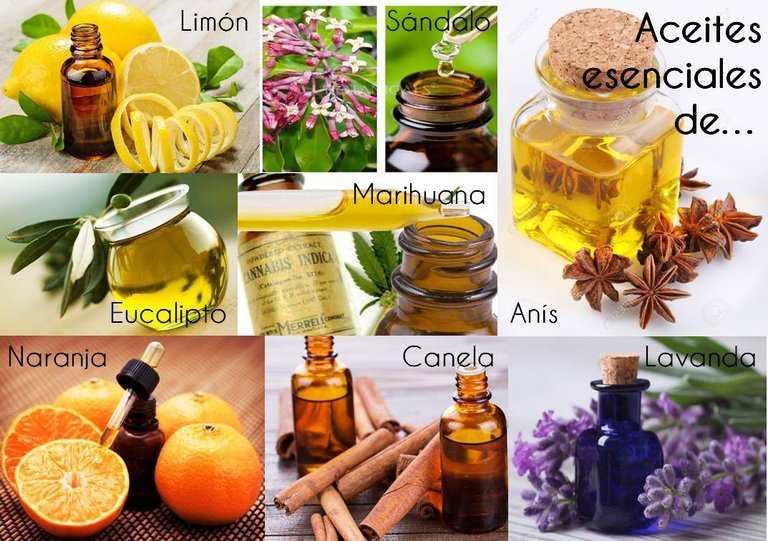
Algunos tipos de aceites esenciales

Aceite esencial de eucalipto
El aceite esencial de eucalipto es una mezcla compleja de monoterpenos, sesquiterpenos y fenoles aromáticos, óxidos, éteres, alcoholes, ésteres, aldehídos y cetonas. Tiene como componente principal el 1,8-cineol que tiene propiedades expectorantes, febrífugas, mucolíticas y antihelmínticas, expectorantes y antisépticas.
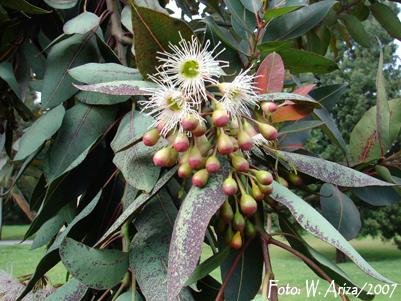
Hojas frutos y flores del eucalipto (Fuente)

Proceso de extracción
Hay muchos procesos para llevar a cabo la extracción de un aceite esencial. El proceso determina la pureza y el costo de la producción; por ejemplo, la extracción por solventes es muy eficiente pero el costo es elevado porque se utilizan como solventes compuestos como el hexano o etanol, además que la pureza del aceite se ve afectada por la dificultad de retirar todo el solvente del aceite extraído. En cambio, la hidrodestilación y la extracción por arrastre con vapor son dos métodos menos eficientes pero más económicos e inocuos. En nuestro caso realizamos la extracción del aceite de eucalipto por arrastre de vapor, operación que realizamos en el equipo multipropósito de la planta piloto de la universidad.
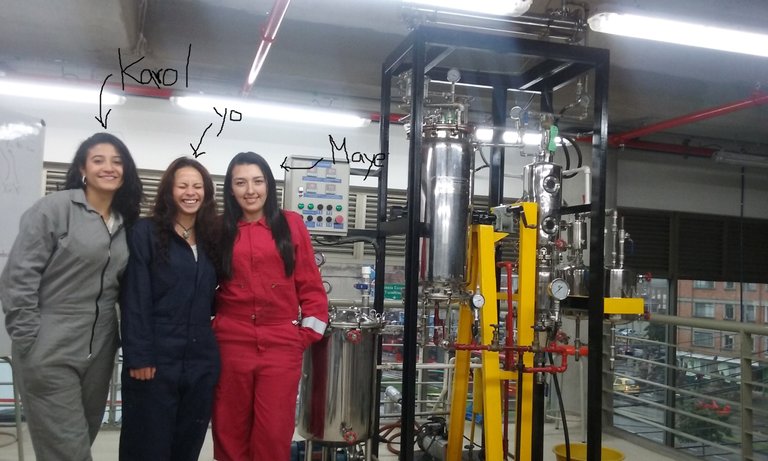
Mis compañeras de proyecto y yo junto al equipo multipropósito ☺

El arrastre por vapor consta de que poner un lecho del material del que se va a extraer el aceite en un tanque. El tanque tiene una entrada de vapor inferior y el vapor arrastra los componentes volátiles de las hojas hacia arriba, como se muestra en la siguiente imagen:
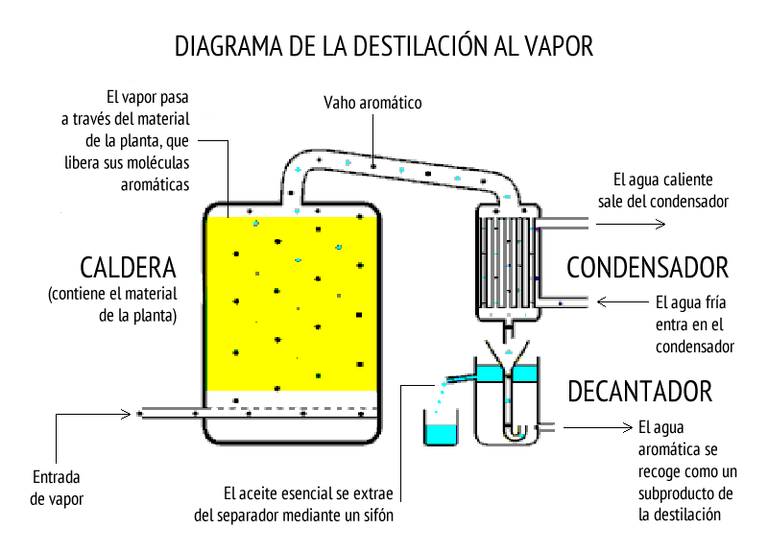
Proceso de arrastre con vapor para extracción de aceites esenciales (Fuente)

La cosa fue así: primero robamos el árbol para luego deshojarlo y cortar cada hoja a un tamaño de 4 cm2 aproximadamente. El tamaño de partícula es importante ya que una hoja pequeña permite que haya un área superficial de contacto más amplia, por ende un rendimiento mayor. Luego se pesaron las hojas y se depositaron en el tanque. Se abrió la entrada del vapor durante 4 horas y media, sacando el destilado (el aceite mezclado con agua) cada media hora. Dicha mezcla se decantó y se obtuvieron así 55 mL de aceite.

La camioneta de Maye con el árbol de eucalipto (en realidad su tía fue quien lo robó jajaja)

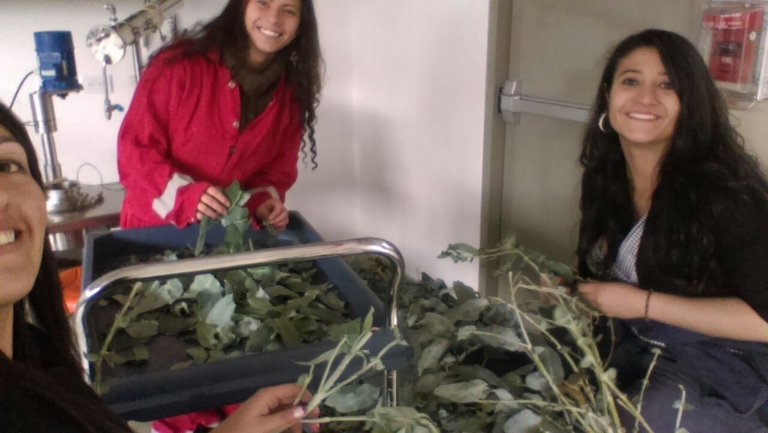
Felices cortando hojas (¡nos tomó 4 horas cortarlas todas!)

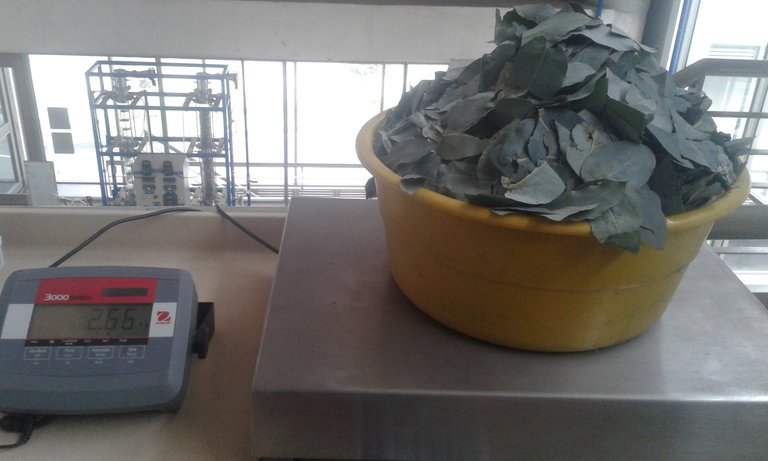
Pesando las hojas… ¡obtuvimos 2 de estos!

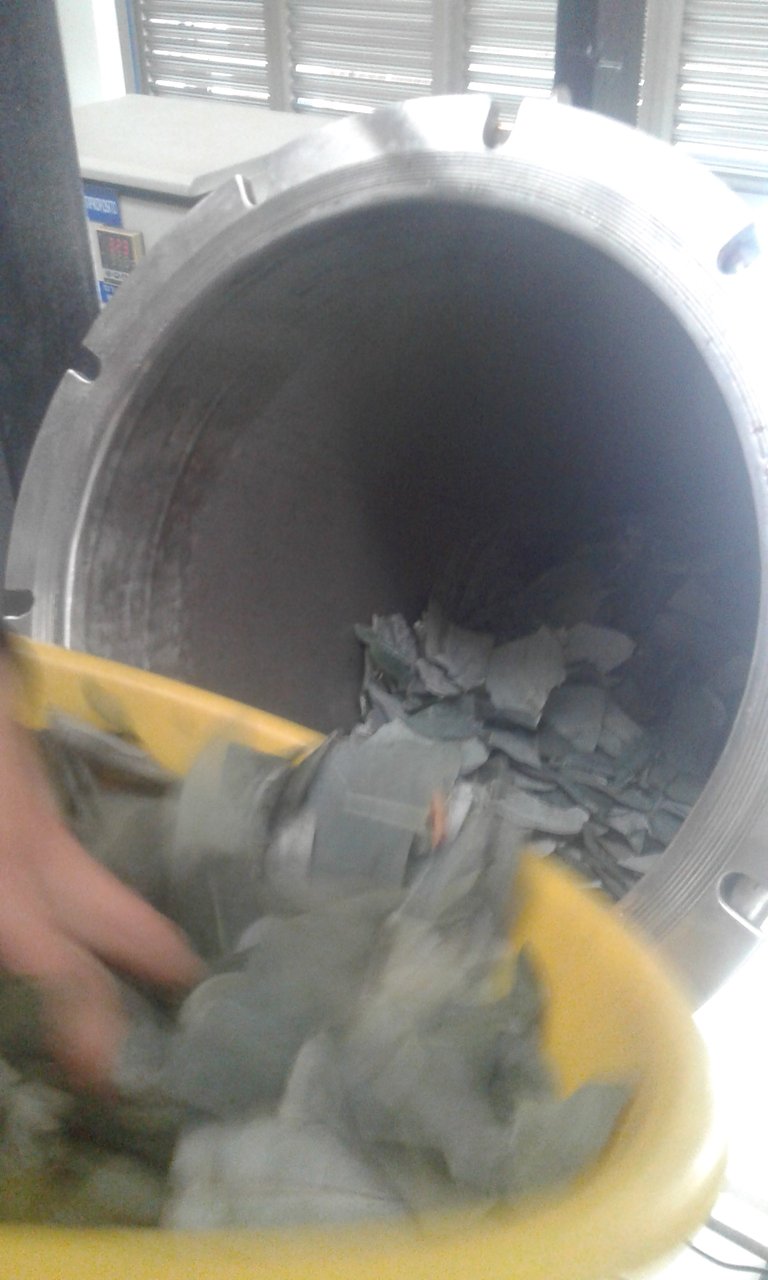
Llenando tanque con 4,6 kg de hojas

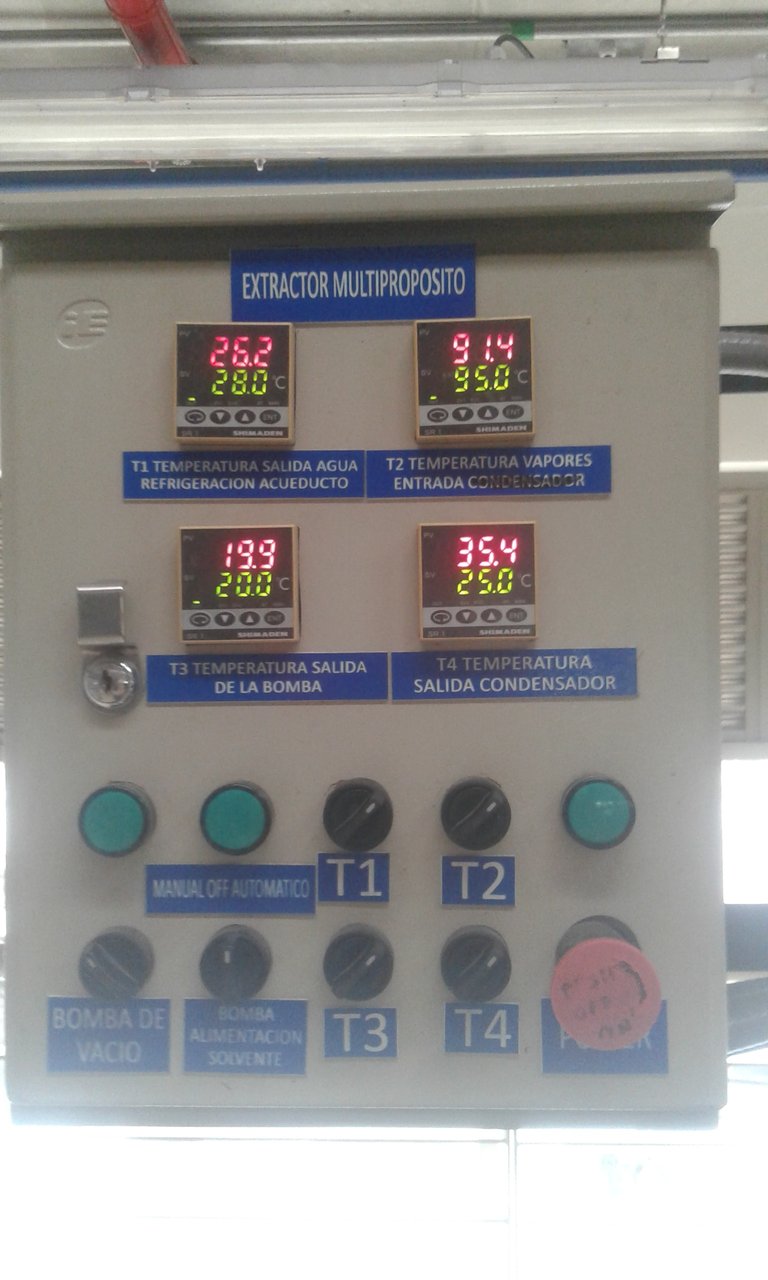
Control de temperatura durante el proceso


Aquí se recolecta la mezcla de aceite esencial y agua


55 mL de aceite esencial decantado

Caracterización del aceite obtenido
Luego de obtener el aceite se realizaron pruebas para determinar su calidad, las cuales se basaron en estándares reportados en artículos científicos. Se realizó un análisis con el espectrofotómetro de infrarrojo (FTIR) y se midió el índice de refracción (grados brix) y la densidad.
| Grados Brix | Densidad (g/mL) | |
|---|---|---|
| Experimental | 68.8 | 0.910 |
| Literatura | 65-70 | 0.922 |
Espectro obtenido con el FTIR
Principales compuestos encontrados en el aceite extraído según el espectro IR: 1,8-cineol (izquierda), α-pineno (centro) y aromadendrene (derecha)
Resultados
Como resultado obtuvimos un aceite de calidad aceptable según la densidad e índice de refracción. El espectro IR permitió determinar que el aceite no está contaminado ya que sólo se ven picos relacionados con compuestos que se esperaban encontrar en el aceite. El rendimiento sin embargo fue de sólo 0,1%, por lo que concluimos que el tamaño de partícula fue el factor determinante, como ya lo había mencionado.
Al final para darle utilidad al aceite extraído hicimos ambientadores, agregando etanol, colorante artificial verde y un poco del aceite esencial.
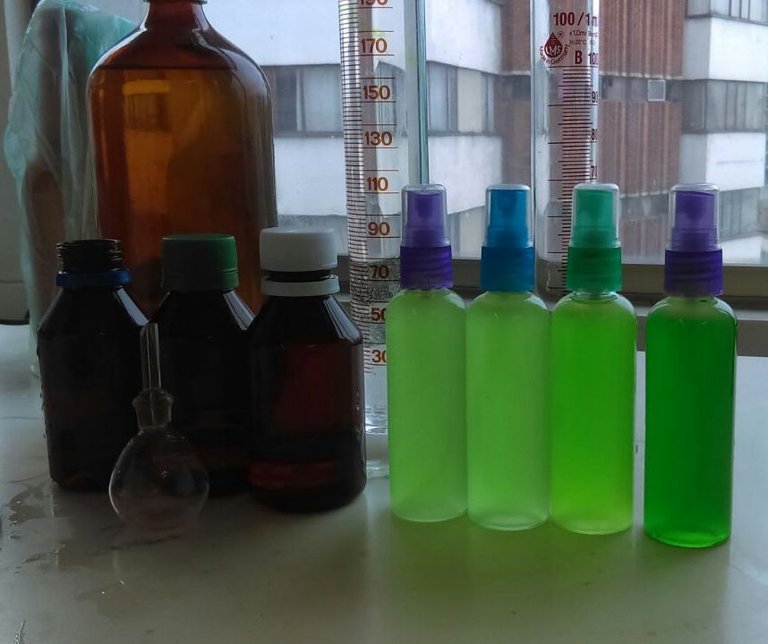
Ambientadores de aceite esencial de eucalipto
Espero les haya gustado nuestro trabajo. ¡Saludos y mil gracias por leerme!☺
Last semester, as a classroom project, we decided with two friends to extract marijuana oil. We wanted to let people know about the wonderful medicinal properties that this oil has, which would change the bad image of the plant and give relevance to the fact that our country, Colombia, can exploit its production without benefiting the drug trade. In the end we couldn’t do it because getting the plant in the quantities we needed (4 kg minimum) was almost economically impossible. Therefore, we chose to steal an eucalyptus tree and extract its oil, whose properties are not far behind those of marijuana...
What are essential oils?
Essential oils are a complex mixture of compounds, usually obtained by secondary metabolites of plants from various biosynthetic pathways, are mainly composed of alcohols, acids, esters, phenols, terpenes, aldehydes among others and are used in areas such as pharmaceutical, Food, cosmetic and aromatherapy. An essential oil is characteristic because its aroma is pleasant and intense and evokes the fragrance of the plant from which it comes.
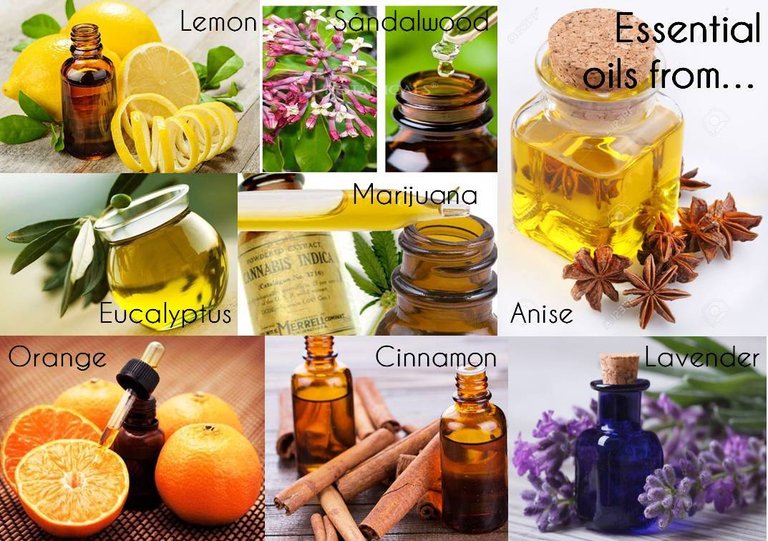
Some essential oils
Eucalyptus Essential Oil
Eucalyptus essential oil is a complex mixture of monoterpenes, sesquiterpenes and aromatic phenols, oxides, ethers, alcohols, esters, aldehydes and ketones. Its main component is 1,8-cineol, which has expectorant, febrile, mucolytic, anthelmintic, expectorant and antiseptic properties.

Leaves, fruits and flowers of eucalyptus (Source)
Extraction process
There are many processes to carry out the extraction of an essential oil. The process determines the purity and cost of production; for example, solvent extraction is very efficient but the cost is high because are used as solvents compounds like hexane or ethanol, in addition that the purity of the oil is affected by the difficulty of removing all the solvent from the extracted oil. In contrast, hydrodistillation and Steam distillation are two less efficient but more economical and innocuous methods. In our case we carried out the extraction of eucalyptus oil by Steam distillation, an operation that we performed in the multipurpose equipment of the pilot plant of the university.

My friends and I (yo) next to the multipurpose equipment☺
Steam distillation consists of putting a litter of the material from which the oil is to be drawn into a tank. The tank has a vapor inlet below and the vapor entrains the volatile components of the leaves upwards, as shown in the following image:
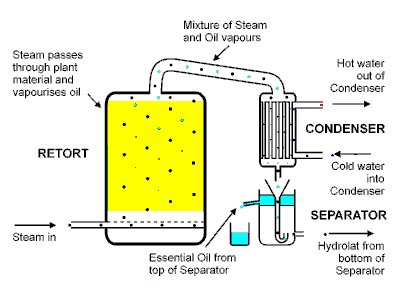
Steam distillation process of essential oils(Source)
The thing was this: first we steal the tree and then de-leaf it and cut each leaf to a size of 4 cm2 approximately. Particle size is important since a small leaf allows a wider contact surface area, thus greater performance. The leaves were then weighed and deposited in the tank. The steam inlet was opened for 4 1/2 hours, removing the distillate (the oil mixed with water) every half hour. This mixture was decanted and then 55 mL of oil was obtained.

Maye’s pickup truck with the Eucalyptus tree (Actually her aunt stole it for us jajaja)

Happy cutting leaves (It took us like four hours!)

Weighing leaves… ¡We got 2 of these!

Filling the tank with 4,6 kg of leaves

Temperature control during the process

Here was recolected the water-essential oil mixture

55 mL of essential oil decanted
Characterization of the obtained oil
After obtaining the oil, tests were performed to determine its quality, which is based on standards reported in scientific articles. An analysis with the infrared spectrophotometer (FTIR) was performed and the refractive index (degrees brix) and density were measured.
Degrees Brix Density (g/mL) Experimental 68.8 0.910 Reference 65-70 0.922
Spectrum obtained with the FTIR
Main compounds found in the extracted oil according to the IR spectrum: 1,8-cineol (left), α-pinene (center) and aromadendrene (right)
Results
As a result we obtained an oil of acceptable quality according to density and refractive index. The IR spectrum allowed to determine that the oil was not contaminated since only are seen peaks related to compounds that were expected to be found in the oil. The yield however was only 0.1%, so we conclude that the particle size was the determining factor, as I had already mentioned.
At the end to give utility to the extracted oil we made air fresheners, adding ethanol, green artificial coloring and some of the essential oil.

Air fresheners of Eucalyptus essential oil
I hope you liked our work. Greetings and thank you so much for Reading me!☺




Principales compuestos encontrados en el aceite extraído según el espectro IR: 1,8-cineol (izquierda), α-pineno (centro) y aromadendrene (derecha)
Resultados
Como resultado obtuvimos un aceite de calidad aceptable según la densidad e índice de refracción. El espectro IR permitió determinar que el aceite no está contaminado ya que sólo se ven picos relacionados con compuestos que se esperaban encontrar en el aceite. El rendimiento sin embargo fue de sólo 0,1%, por lo que concluimos que el tamaño de partícula fue el factor determinante, como ya lo había mencionado.
Al final para darle utilidad al aceite extraído hicimos ambientadores, agregando etanol, colorante artificial verde y un poco del aceite esencial.

Ambientadores de aceite esencial de eucalipto
Espero les haya gustado nuestro trabajo. ¡Saludos y mil gracias por leerme!☺
Last semester, as a classroom project, we decided with two friends to extract marijuana oil. We wanted to let people know about the wonderful medicinal properties that this oil has, which would change the bad image of the plant and give relevance to the fact that our country, Colombia, can exploit its production without benefiting the drug trade. In the end we couldn’t do it because getting the plant in the quantities we needed (4 kg minimum) was almost economically impossible. Therefore, we chose to steal an eucalyptus tree and extract its oil, whose properties are not far behind those of marijuana...
What are essential oils?
Essential oils are a complex mixture of compounds, usually obtained by secondary metabolites of plants from various biosynthetic pathways, are mainly composed of alcohols, acids, esters, phenols, terpenes, aldehydes among others and are used in areas such as pharmaceutical, Food, cosmetic and aromatherapy. An essential oil is characteristic because its aroma is pleasant and intense and evokes the fragrance of the plant from which it comes.

Some essential oils
Eucalyptus Essential Oil
Eucalyptus essential oil is a complex mixture of monoterpenes, sesquiterpenes and aromatic phenols, oxides, ethers, alcohols, esters, aldehydes and ketones. Its main component is 1,8-cineol, which has expectorant, febrile, mucolytic, anthelmintic, expectorant and antiseptic properties.

Leaves, fruits and flowers of eucalyptus (Source)
Extraction process
There are many processes to carry out the extraction of an essential oil. The process determines the purity and cost of production; for example, solvent extraction is very efficient but the cost is high because are used as solvents compounds like hexane or ethanol, in addition that the purity of the oil is affected by the difficulty of removing all the solvent from the extracted oil. In contrast, hydrodistillation and Steam distillation are two less efficient but more economical and innocuous methods. In our case we carried out the extraction of eucalyptus oil by Steam distillation, an operation that we performed in the multipurpose equipment of the pilot plant of the university.

My friends and I (yo) next to the multipurpose equipment☺
Steam distillation consists of putting a litter of the material from which the oil is to be drawn into a tank. The tank has a vapor inlet below and the vapor entrains the volatile components of the leaves upwards, as shown in the following image:

Steam distillation process of essential oils(Source)
The thing was this: first we steal the tree and then de-leaf it and cut each leaf to a size of 4 cm2 approximately. Particle size is important since a small leaf allows a wider contact surface area, thus greater performance. The leaves were then weighed and deposited in the tank. The steam inlet was opened for 4 1/2 hours, removing the distillate (the oil mixed with water) every half hour. This mixture was decanted and then 55 mL of oil was obtained.

Maye’s pickup truck with the Eucalyptus tree (Actually her aunt stole it for us jajaja)

Happy cutting leaves (It took us like four hours!)

Weighing leaves… ¡We got 2 of these!

Filling the tank with 4,6 kg of leaves

Temperature control during the process

Here was recolected the water-essential oil mixture

55 mL of essential oil decanted
Characterization of the obtained oil
After obtaining the oil, tests were performed to determine its quality, which is based on standards reported in scientific articles. An analysis with the infrared spectrophotometer (FTIR) was performed and the refractive index (degrees brix) and density were measured.
Degrees Brix Density (g/mL) Experimental 68.8 0.910 Reference 65-70 0.922
Spectrum obtained with the FTIR
Main compounds found in the extracted oil according to the IR spectrum: 1,8-cineol (left), α-pinene (center) and aromadendrene (right)
Results
As a result we obtained an oil of acceptable quality according to density and refractive index. The IR spectrum allowed to determine that the oil was not contaminated since only are seen peaks related to compounds that were expected to be found in the oil. The yield however was only 0.1%, so we conclude that the particle size was the determining factor, as I had already mentioned.
At the end to give utility to the extracted oil we made air fresheners, adding ethanol, green artificial coloring and some of the essential oil.

Air fresheners of Eucalyptus essential oil
I hope you liked our work. Greetings and thank you so much for Reading me!☺



Resultados
Como resultado obtuvimos un aceite de calidad aceptable según la densidad e índice de refracción. El espectro IR permitió determinar que el aceite no está contaminado ya que sólo se ven picos relacionados con compuestos que se esperaban encontrar en el aceite. El rendimiento sin embargo fue de sólo 0,1%, por lo que concluimos que el tamaño de partícula fue el factor determinante, como ya lo había mencionado.
Al final para darle utilidad al aceite extraído hicimos ambientadores, agregando etanol, colorante artificial verde y un poco del aceite esencial.

Ambientadores de aceite esencial de eucalipto

Espero les haya gustado nuestro trabajo. ¡Saludos y mil gracias por leerme!☺
Last semester, as a classroom project, we decided with two friends to extract marijuana oil. We wanted to let people know about the wonderful medicinal properties that this oil has, which would change the bad image of the plant and give relevance to the fact that our country, Colombia, can exploit its production without benefiting the drug trade. In the end we couldn’t do it because getting the plant in the quantities we needed (4 kg minimum) was almost economically impossible. Therefore, we chose to steal an eucalyptus tree and extract its oil, whose properties are not far behind those of marijuana...
What are essential oils?
Essential oils are a complex mixture of compounds, usually obtained by secondary metabolites of plants from various biosynthetic pathways, are mainly composed of alcohols, acids, esters, phenols, terpenes, aldehydes among others and are used in areas such as pharmaceutical, Food, cosmetic and aromatherapy. An essential oil is characteristic because its aroma is pleasant and intense and evokes the fragrance of the plant from which it comes.

Some essential oils

Eucalyptus Essential Oil
Eucalyptus essential oil is a complex mixture of monoterpenes, sesquiterpenes and aromatic phenols, oxides, ethers, alcohols, esters, aldehydes and ketones. Its main component is 1,8-cineol, which has expectorant, febrile, mucolytic, anthelmintic, expectorant and antiseptic properties.

Leaves, fruits and flowers of eucalyptus (Source)

Extraction process
There are many processes to carry out the extraction of an essential oil. The process determines the purity and cost of production; for example, solvent extraction is very efficient but the cost is high because are used as solvents compounds like hexane or ethanol, in addition that the purity of the oil is affected by the difficulty of removing all the solvent from the extracted oil. In contrast, hydrodistillation and Steam distillation are two less efficient but more economical and innocuous methods. In our case we carried out the extraction of eucalyptus oil by Steam distillation, an operation that we performed in the multipurpose equipment of the pilot plant of the university.

My friends and I (yo) next to the multipurpose equipment☺

Steam distillation consists of putting a litter of the material from which the oil is to be drawn into a tank. The tank has a vapor inlet below and the vapor entrains the volatile components of the leaves upwards, as shown in the following image:

Steam distillation process of essential oils(Source)

The thing was this: first we steal the tree and then de-leaf it and cut each leaf to a size of 4 cm2 approximately. Particle size is important since a small leaf allows a wider contact surface area, thus greater performance. The leaves were then weighed and deposited in the tank. The steam inlet was opened for 4 1/2 hours, removing the distillate (the oil mixed with water) every half hour. This mixture was decanted and then 55 mL of oil was obtained.

Maye’s pickup truck with the Eucalyptus tree (Actually her aunt stole it for us jajaja)


Happy cutting leaves (It took us like four hours!)


Weighing leaves… ¡We got 2 of these!


Filling the tank with 4,6 kg of leaves


Temperature control during the process


Here was recolected the water-essential oil mixture


55 mL of essential oil decanted

Characterization of the obtained oil
After obtaining the oil, tests were performed to determine its quality, which is based on standards reported in scientific articles. An analysis with the infrared spectrophotometer (FTIR) was performed and the refractive index (degrees brix) and density were measured.
| Degrees Brix | Density (g/mL) | |
|---|---|---|
| Experimental | 68.8 | 0.910 |
| Reference | 65-70 | 0.922 |
Spectrum obtained with the FTIR
Main compounds found in the extracted oil according to the IR spectrum: 1,8-cineol (left), α-pinene (center) and aromadendrene (right)
Results
As a result we obtained an oil of acceptable quality according to density and refractive index. The IR spectrum allowed to determine that the oil was not contaminated since only are seen peaks related to compounds that were expected to be found in the oil. The yield however was only 0.1%, so we conclude that the particle size was the determining factor, as I had already mentioned.
At the end to give utility to the extracted oil we made air fresheners, adding ethanol, green artificial coloring and some of the essential oil.

Air fresheners of Eucalyptus essential oil
I hope you liked our work. Greetings and thank you so much for Reading me!☺


Main compounds found in the extracted oil according to the IR spectrum: 1,8-cineol (left), α-pinene (center) and aromadendrene (right)
Results
As a result we obtained an oil of acceptable quality according to density and refractive index. The IR spectrum allowed to determine that the oil was not contaminated since only are seen peaks related to compounds that were expected to be found in the oil. The yield however was only 0.1%, so we conclude that the particle size was the determining factor, as I had already mentioned.
At the end to give utility to the extracted oil we made air fresheners, adding ethanol, green artificial coloring and some of the essential oil.

Air fresheners of Eucalyptus essential oil
I hope you liked our work. Greetings and thank you so much for Reading me!☺

Results
As a result we obtained an oil of acceptable quality according to density and refractive index. The IR spectrum allowed to determine that the oil was not contaminated since only are seen peaks related to compounds that were expected to be found in the oil. The yield however was only 0.1%, so we conclude that the particle size was the determining factor, as I had already mentioned.
At the end to give utility to the extracted oil we made air fresheners, adding ethanol, green artificial coloring and some of the essential oil.

Air fresheners of Eucalyptus essential oil

I hope you liked our work. Greetings and thank you so much for Reading me!☺




es un proceso un poco complicado. Quie fuese a pensar.
followed (:
Tu crees? Bueno, no lo es tanto, de pronto mi redacción no facilitó las cosas jajaja Aprecio tu comentario! Gracias :)